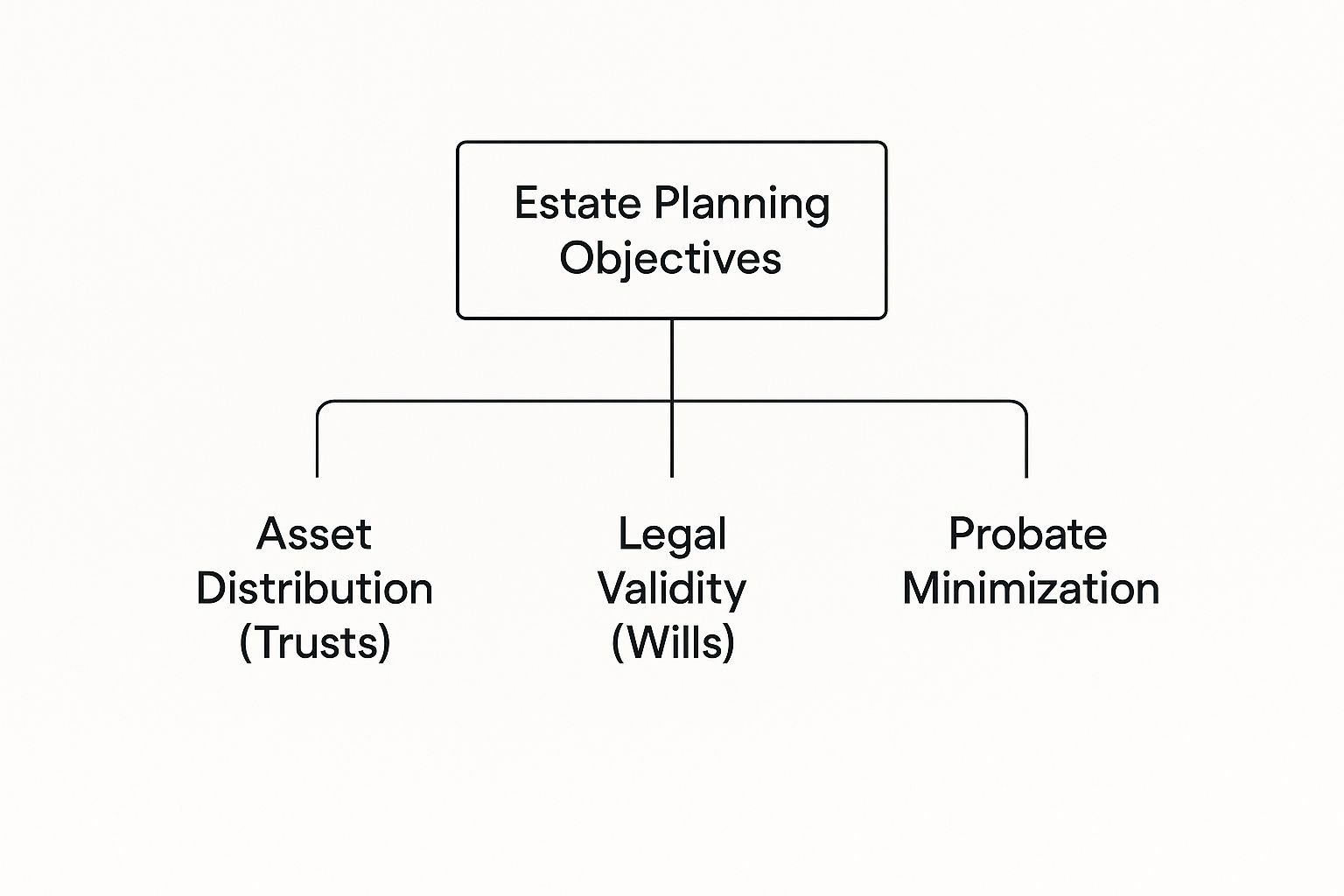A Guide to Estate Planning for Generational Wealth
- Parkview Partners Capital Management
- Oct 22
- 4 min read
Thoughtful estate planning for generational wealth extends far beyond drafting a simple will. It’s about creating a comprehensive roadmap designed not only to transfer assets but also to support your family’s financial future and values for generations. A proactive, well-structured plan preserves wealth, fosters communication, and helps prepare heirs for responsible stewardship.

Defining Your Legacy Beyond Simple Inheritance
A common misconception is that wealth accumulation alone ensures a lasting legacy. Yet research shows that many family fortunes diminish by the second or third generation — not due to lack of assets, but lack of planning and shared vision.
Source: Expat Wealth at Work, https://expatwealthatwork.com/blog/2025/05/12/why-most-wealth-vanishes-after-the-first-generation/#:~:text=Studies%20reveal%2060%25%20of%20family,a%20different%20approach%20to%20inheritance.
Effective estate planning can change this outcome. It’s a deliberate, values-based process focused on building a framework that supports beneficiaries, prevents conflict, and sustains the family mission long after you’re gone.
A Proactive Approach to Wealth Preservation
A well-conceived estate plan identifies potential challenges and implements strategies before they arise. Beyond transferring assets, it aims to help preserve wealth, educate heirs, and mitigate risks.
Key Benefits of a Comprehensive Plan:
Tax Mitigation: Reduce federal and state estate taxes to preserve more for your family.
Asset Preservation: Shield wealth from creditors, lawsuits, or heirs’ financial missteps.
Conflict Prevention: Clearly written intentions help prevent disputes and confusion.
Financial Education: Prepare heirs to become responsible, capable stewards of family assets.
Estate planning isn’t just for the ultra-wealthy. Anyone wishing to pass down values and assets can benefit from a structured, professional approach.
The Unprecedented Scale of Modern Wealth Transfer
We are entering the largest intergenerational wealth transfer in modern history. Trillions of dollars are expected to move between generations — not just as assets, but as responsibility, stewardship, and family identity.
Global Perspective:Over $83 trillion in wealth is projected to transfer from Baby Boomers to their heirs by 2048. Without proper planning, taxes and legal complexities can erode even the most carefully built fortunes.
Source: Capgemini, https://www.capgemini.com/insights/research-library/world-wealth-report/
This isn’t just a financial event — it’s a cultural shift. The next generation’s priorities differ, emphasizing digital management, ESG-aligned investments, and socially conscious stewardship. Estate plans must be both robust and adaptable to reflect these changing values.
Implementation Considerations:
Encourage Open Communication: Discuss financial values and expectations early.
Include Education: Prepare heirs through structured financial learning.
Modernize Plans: Update for digital assets and new technologies.
Work with Advisors: Choose professionals familiar with evolving family and tax dynamics.

Core Strategies for Tax-Efficient Wealth Transfer
Estate planning is about much more than distributing assets — it’s about designing a structure to preserve and manage family wealth efficiently.
Grantor Retained Annuity Trusts (GRATs)
A GRAT allows you to transfer appreciating assets to heirs with minimal gift tax. The grantor receives annual annuity payments for a set term; any asset growth beyond the IRS rate can pass to beneficiaries potentially tax-free.
Implementation Considerations:
May be suited for assets expected to appreciate rapidly.
Choose an optimal term length for growth vs. mortality risk.
Monitor market conditions to time asset transfers effectively.
Irrevocable Life Insurance Trusts (ILITs)
An ILIT creates tax-free liquidity for heirs. The trust owns a life insurance policy on your life, keeping proceeds out of your taxable estate and providing funds to pay estate taxes or other expenses.
Implementation Considerations:
The trust must own and fund the policy directly.
Include “Crummey” powers for annual gift tax exclusion. Crummey powers are a stipulation in irrevocable trusts where beneficiaries can withdraw assets within 30 days of contribution.
Appoint an experienced trustee to maintain compliance.
Dynasty Trusts
A Dynasty Trust extends your legacy across multiple generations, may help shield assets from estate and generation-skipping taxes.
Implementation Considerations:
Choose a favorable state jurisdiction for longevity and flexibility.
Draft clear distribution guidelines for future heirs.
Include adaptability for changing family or legal circumstances.

Why Family Governance May Be Your Strongest Asset
Even the best-structured financial plans can falter if the next generation isn’t prepared. Family governance builds the human infrastructure behind the wealth — aligning heirs through shared purpose, communication, and education.
Creating a Family Mission Statement
A mission statement captures your family’s values and long-term purpose. It serves as a “constitution,” guiding financial decisions and fostering unity across generations.
Establishing a Family Council
A family council can act as a governing body — a structured forum to manage collective decision-making and maintain transparency.
Implementation Considerations:
Define clear roles and responsibilities in a written charter.
Use meetings to educate younger members about finance and philanthropy.
Encourage open communication and involve neutral advisors when needed.
Planning for the Realities of Concentrated Wealth
Modern estates often include illiquid or concentrated assets — like private businesses, stock holdings, or real estate portfolios. These require specialized strategies to manage valuation, liquidity, and taxation.
Implementation Considerations:
Valuation Planning: Obtain regular professional appraisals.
Succession Planning: Use buy-sell agreements and life insurance to facilitate transitions.
Strategic Diversification: Reduce concentration risk through structured sales or charitable contributions.
Liquidity Creation: Tools like ILITs can generate tax-free cash for estate obligations.

Weaving Your Legacy with Strategic Philanthropy
Philanthropy can unite families while offering tax efficiency and lasting impact. Charitable giving — through Charitable Remainder Trusts (CRTs) or Donor-Advised Funds (DAFs) — transforms generosity into strategy.
Implementation Considerations:
Define Your Mission: Clarify core causes and family purpose.
Engage Future Generations: Include children and grandchildren in giving decisions.
Select the Right Vehicle: Compare CRTs, DAFs, and private foundations for the best fit.
Establish Governance: Set decision-making processes and impact measures for transparency.
When philanthropy becomes part of the family story, wealth transforms into legacy.
Putting It All Together: Your Family's Lasting Legacy
Estate planning for generational wealth is an evolving process — blending financial foresight, tax strategy, education, and communication. With trillions in wealth changing hands in coming decades, now is the time to act.
The most successful plans do more than transfer assets — they prepare heirs to lead, ensuring your legacy remains strong for generations.
To discuss how these strategies may apply to your unique situation, contact Parkview Partners Capital Management for a personalized consultation at www.parkviewpcm.com.
Investment advice offered through Stratos Wealth Partners, Ltd., a registered investment advisor. Stratos Wealth Partners, Ltd. and Parkview Partners Capital Management are separate entities. Neither Stratos nor Parkview Partners Capital Management provides legal or tax advice. Please consult legal or tax professionals for specific information regarding your individual situation. Please consult with your professional advisors before taking any action. Past performance is not a guarantee of future results.
Comments